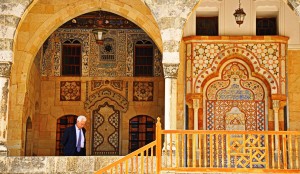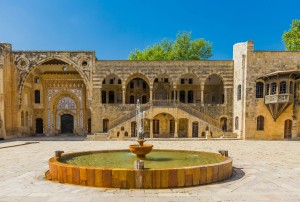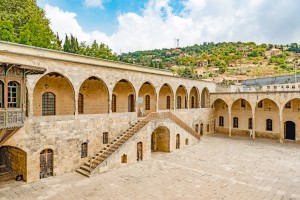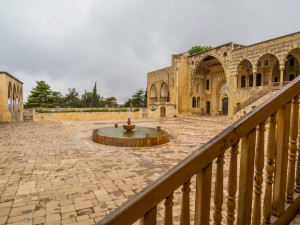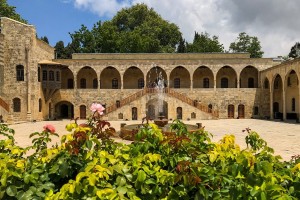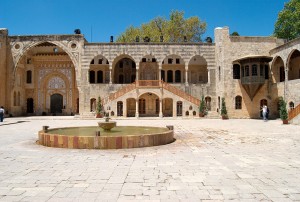Nestled 850 meters above sea level in the scenic Chouf Mountains, Beit ed-Dine Palace (also spelled Beiteddine) stands as a magnificent testament to Lebanon’s glorious past and architectural beauty. With its opulent halls, lush courtyards, and rich history, this 19th-century palace is not just a monument—it’s a story carved in stone, waiting to enchant every visitor who walks through its grand gates.
A Journey Through Time
The palace was the vision of Emir Bechir Chehab II, the ruler of Mount Lebanon for over half a century. Built over a span of 30 years starting in the early 1800s, the site was once a humble Druze hermitage (khalwa). Emir Bechir transformed it into a masterpiece that blended traditional Lebanese architecture with Syrian and Damascene artistry—earning it the nickname, “The Lebanese Alhambra.”
To supply the palace with water, the Emir enlisted all male subjects in 1812 to contribute two days of labor yearly. Within two years and 80,000 days of work, the palace’s water system was completed—a marvel of community and engineering.
Though Emir Bechir was exiled in 1840, the palace lived many lives: as a government seat during Ottoman rule, a French Mandate administrative office, and since 1943, the official summer residence of the Lebanese President.
What to Expect on Your Visit
Beit ed-Dine Palace is not just one building—it’s a complex of historical wings, gardens, museums, and architectural wonders. Here’s a glimpse of what awaits you:
🏛 Dar el-Baraniyyeh – The Outer Courtyard
Your journey begins at the main entrance, guarded by twin lion sculptures. You’ll walk through an arched passage that opens into al-Midan, a vast 107 x 45-meter courtyard where horsemen and dignitaries once gathered. Alongside lies al-Madafa, the guest reception hall, traditionally used to host travelers for three days before inquiring about their identity—a tribute to Lebanese hospitality.
📸 Don’t miss: The miniature model of the entire palace for an overview before your exploration.
🌿 Dar el-Wousta – The Administrative Wing
A double stairway leads to this green haven of charming courtyards, colorful mosaics, and intricate arcades. Here, you’ll find the offices, reception halls, and apartments of palace officials, including Boutros Karami, the Emir’s minister.
The standout feature? A stunning courtyard surrounded by arched fountains, marble decor, calligraphic inscriptions, and brass braziers—designed to offer cool breezes in summer and warmth in winter.
👑 Dar el-Harim – The Private Royal Quarters
This wing reveals the most personal side of the palace—the Emir’s private apartments and his reception room known as the Salamlik, built on two levels with exquisite colored marble and Quranic calligraphy. One of the rooms even hosted the French poet Alphonse de Lamartine in 1833.
Nearby, the palace baths or hammams—once considered the finest in the Arab world—follow ancient Roman tradition with warm and cold rooms (tepidarium and frigidarium), vaulted ceilings, and garden views.
📍 Highlight: The tomb of Emir Bechir and his wife Sitt Shams lies in a serene corner of the palace grounds.
🖼 Museums & Exhibits
Beneath Dar el-Wousta and Dar el-Harim, once home to 600 horses and 500 soldiers, you’ll find a rich collection of Byzantine mosaics, Islamic-era glazed pottery, Bronze Age relics, Roman glass, and antique weapons. The ethnographic displays of feudal-era costumes and jewelry give you a window into the aristocratic life of the time.
🏨 Palace of Emir Amine – Now a Luxury Hotel
Overlooking the main palace, this smaller gem was built for Emir Bechir’s son, Amine, and is now a beautifully restored boutique hotel. It blends history with comfort, offering visitors a chance to sleep within royal walls.
How to Get There
To reach Beit ed-Dine Palace, follow a scenic drive that takes you through Deir el Qamar and past the famous Mousa Castle—a fairy-tale stop of its own. The road from Deir el Qamar to Beit ed-Dine is about 6 kilometers and full of charming views.
Visitor Information
Why Visit Beit ed-Dine?
-
🇱🇧 Experience the richest example of 19th-century Lebanese architecture
-
📚 Walk through centuries of political and cultural history
-
🖼 Explore museum collections of mosaics, antiques, and royal artifacts
-
🏞 Stroll through breathtaking gardens and panoramic mountain views
-
🛏 Stay in a palace-turned-hotel for an unforgettable night
Final Thoughts
Whether you’re a history buff, an architecture lover, or a traveler seeking off-the-beaten-path experiences, Beit ed-Dine Palace is one of Lebanon’s crown jewels. It’s a place where the stories of emirs, poets, and ancient civilizations live on in stone, mosaic, and memory.
So, next time you’re in Lebanon, skip the usual city spots and head to the hills of Chouf—where the palace of Emir Bechir awaits, ready to take you on a royal journey through Lebanon’s timeless heritage.
